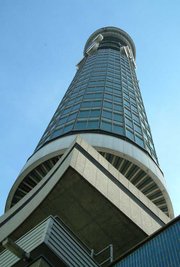BT Tower
|
|
- For other BT Towers, see BT Tower (disambiguation).
BT_Tower_2004.jpg
The BT Tower in London, previously the Post Office Tower, is a strikingly tall cylindrical building at 60 Cleveland Street, W1. The main structure is 175 metres (574 feet) tall, with a further section of aerial bringing the total height to 188 metres (620 feet).
| Contents |
History of the Post Office Tower
The tower was commissioned by the General Post Office (GPO). Its primary purpose was to support the microwave aerials then used to carry telecommunications traffic from London to the rest of the country.
The tower was designed by the architects of the Ministry of Public Building and Works: the chief architects were Eric Bedford and G. R. Yeats. Typically for its time, the building is concrete clad in glass. The narrow cylinder shape was chosen because of the requirements of the communications aerials: the building will shift no more than 25 cm in wind speeds of up to 150 km/h. Initially the first sixteen floors were for technical equipment and power, above that was a 35 metre section for the microwave aerials, and above that were six floors of suites, kitchens, technical equipment and finally a gridwork aerial. To prevent heat build-up the glass cladding was of a special tint. The construction cost was £2.5 million.
Construction began in June 1961. The tower was topped out on July 15, 1964 and it was operational from October 8, 1965. The building contractors were Peter Lind & Company.
The tower was officially opened to the public on May 16, 1966 by Tony Benn and Billy Butlin. As well as the communications gear and office space there were viewing galleries, a souvenir shop, and a slowly rotating restaurant, the "Top of the Tower", on the 34th floor, operated by Butlins. It made one revolution every 22 minutes.
A suspected IRA bomb exploded in the roof of the men's toilets at the Top of the Tower on October 31, 1971 and it was subsequently closed to the public for security reasons. The restaurant closed in 1980 when Butlins' lease expired and non-BT-approved access to the building ceased. In 1981 it was superseded as the tallest building in Britain by the NatWest Tower (renamed Tower 42).
The London BT Tower today
When the GPO telecommunications services were split off in 1981 (in advance of the 1984 privatisation) the tower was renamed the London Telecom Tower. After the rebranding of the company in 1992 it became the BT Tower. The building is still not open to the public. The restaurant has been re-opened, and is now used by BT for corporate sponsorship events and promotions: since the re-discovery of spare parts for the mechanism, they even rotate it occasionally.
In 2004 the DJ Brian Transeau (who goes by the stage name BT) did a concert at the site that was carried on BBC Radio 1, leading to utter confusion for worldwide online listeners and others who are less than familiar with the structure.
The tower is still in use, and is the site of a major UK communications hub. Fiber optic links have replaced microwave links for most mainstream purposes, but the tower is still used for microwave links. The base of the tower contains the TV Network Switching Centre which carries broadcasting traffic and relays signals used by the BBC and other television broadcasters.
A recent renovation installed coloured lighting behind a new translucent panel bearing the company logo, progammed to vary constantly at night.
The BT Tower was given grade II listed building status in 2003.
See also
External links
- lightstraw.co.uk feature on the BT Tower (http://lightstraw.co.uk/ate/main/postofficetower/)
- Urban75 feature on the BT Tower (http://www.urban75.org/london/telecom.html)
- Guardian article on the BT Tower (http://www.guardian.co.uk/arts/critic/feature/0,1169,641870,00.html)
- Connected Earth BT Tower flash site (http://www.connected-earth.com/Learnit/Teachers/CommunicationProjects-Primary/PrimaryProject3/Interactivegames/BTTower/bttower.htm)
- Last Weekend Sunrise Party of 2004 (http://www.bbc.co.uk/radio1/dance/nightingale/bt/index.shtml)

